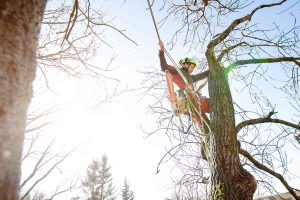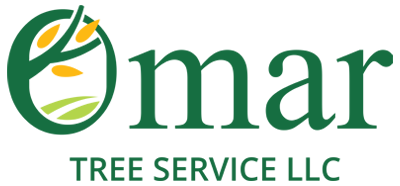Step outside and take a moment to appreciate the majestic trees that surround us. They stand tall, providing shade on scorching summer days and painting landscapes with their vibrant hues in the fall. But have you ever stopped to think about how these marvelous giants stay healthy and beautiful year after year? The answer lies in regular trimming – an essential practice often overlooked by many homeowners. In this blog post, we’ll delve into the importance of maintaining your trees through proper trimming techniques, revealing just how frequently this task should be tackled for optimum plant health benefits. Get ready to unlock the secrets behind stunningly maintained trees!”
Why tree trimming is important?
Trees are an essential part of our ecosystem, providing us with oxygen, shade, and beauty. They also play a crucial role in maintaining the balance of nature by absorbing harmful pollutants and releasing clean air. As such, it is important to take care of these natural wonders to ensure their health and longevity.
One vital aspect of tree care is regular trimming. Many homeowners may overlook this task or only do it when absolutely necessary. However, the truth is that proper tree trimming is crucial for maintaining the overall health and appearance of your tree growth. In this section, we will delve into why this is so important.
Promotes Tree Health:- It involves removing dead, diseased, or damaged branches from a tree’s canopy. These branches can be hazardous as they can fall off at any time and cause damage to people or property below. They can also serve as an entry point for pests and diseases that can harm the entire tree.
By regularly trimming your trees, you are preventing these potential risks and promoting overall health. Removing dead or diseased branches allows for better air circulation within the canopy, reducing the chances of fungal infections or pest infestations.
Encourages Growth:- When a tree’s canopy becomes too dense due to lack of pruning or trimming, it restricts sunlight from reaching its inner branch tissues and leaves. This results in stunted growth and dead limbs that cannot support its weight.
What happens if trees are not trimmed regularly?
Trees are an essential part of our environment and provide us with numerous benefits, such as clean air, shade, and aesthetic appeal. However, just like any other living thing, It require regular maintenance to stay healthy and thrive. One crucial aspect of maintenance is trimming.
It involves removing specific branches to improve its overall health and appearance. Many homeowners may overlook the importance of it, resulting in potential consequences for their trees and property. In this section, we will discuss what happens if trees are not trimmed regularly.
1) Overgrown Branches Can Cause future Damage: Trees that are not regularly trimmed can develop overgrown branches that pose a risk to surrounding structures and people, potentially causing you to invest in expensive exterior home improvement services. These branches can easily break off during strong winds or storms and cause collateral damage to roofs, windows, vehicles or even injure people. This is especially true for larger trees with heavy limbs that can be difficult to control if left untrimmed.
2) Diseases Can Spread: Dead or diseased branches can quickly spread infections to the rest of the hazardous tree if they are not removed promptly through trimming. These diseases weaken the immune system and make it more susceptible to further damage from pests or harsh weather conditions. Regularly trimming allows you to identify these problem areas early on and prevent them from spreading.
3) Impedes Growth: When it is not trimmed regularly, it can become overcrowded with too many branches competing for sunlight and nutrients.
Factors to consider when determining how often to trim. Recommended frequency for tree trimming based on various factors
Trimming is an important aspect of maintenance that should not be overlooked. Regular trimming can help improve the health, as well as prevent potential safety hazards. However, determining how often to trim can be a bit tricky as it depends on various factors such as age, species, and location. In this section, we will discuss each of these factors in detail to help you make an informed decision on how often you should trim.
- Age: The age plays a significant role in determining its tree pruning needs. Younger trees require more frequent trimming compared to mature ones. This is because young trees have faster growth rates and are still establishing their structure. Therefore, they need more attention to ensure proper growth and development. Trimming young trees every 2-3 years is recommended for strong growth. On the other hand, mature trees have stronger root systems and are less susceptible to diseases or pests. These types only need trimming every 3-5 years or even longer depending on their condition.
- Species: Different tree species have different growth rates and characteristics that affect how often they should be trimmed. For example, fast-growing species like willows or poplars may require more frequent trimming than slower-growing ones like oaks or maple tree.Additionally, certain species are prone to specific diseases or pests that may require corrective pruning as a preventive measure.
- Location: The location of your trees also plays a significant role in determining how often they need to be trimmed. Trees growing in urban areas with heavy traffic or high winds may need more frequent pruning than those in rural areas with less external stressors.
- Tree Type:The first factor to consider when determining the frequency of tree trimming is the type of tree. Each species has its own growth rate and proper pruning needs. For instance, fast-growing trees like maples or birches may require more frequent trimming compared to slow-growing ones like pine or Oak tree. It is essential to research the specific needs of your tree species before deciding on a trimming schedule.
- Overall Condition: It is important to regularly inspect the overall condition to determine if they need any immediate attention.
Benefits of regular tree trimming ( improved safety, and aesthetic appeal)
Regular tree trimming is an essential aspect of maintaining beautiful and healthy trees. It involves the removal of dead or damaged branches, shaping the canopy, and maintaining appropriate size and structure of the tree. While many people may overlook the importance of regular tree trimming, it has numerous benefits that make it a necessary task for any homeowner or property owner.
In this section, we will discuss in detail some of the top benefits that come with regular tree trimming:
- Healthier Trees: Just like humans, trees also need proper care to stay healthy. Regular trimming plays a crucial role in maintaining the overall health and well-being of your trees. By removing dead, diseased, or damaged branches, you are preventing potential diseases from spreading to other parts of the tree. This promotes healthy growth and prevents issues such as rotting or decay that can lead to the death of the entire tree. Moreover, by thinning out dense canopies through pruning, you allow more sunlight and air circulation to reach all parts of the tree. This not only promotes better photosynthesis but also helps prevent pest infestations.
- Improved Safety: Overgrown trees with weak or dead branches can pose a significant safety hazard for your property and those around it. These branches can fall unexpectedly due to wind or heavy rain, causing damage to your home or even injuring someone.
Regularly trimming your trees reduces these risks by removing weak branches before they become a problem. It also ensures that there is enough clearance between your trees and nearby structures.
Risks of over-trimming or under-trimming trees

Tree trimming is an essential part of maintenance and should be done regularly to ensure the natural shape health and safety of your trees for future growth. However, like any other task, there are certain risks involved in tree trimming that need to be taken into consideration. In this section, we will discuss the potential risks of over-trimming or under-trimming trees.
Over-trimming refers to removing too many tree branches and leaves from a tree, while under-trimming involves not cutting enough or neglecting to trim altogether. Both of these practices can have detrimental effects on the health and well-being of your trees.
One of the main risks associated with over-trimming is that it can weaken the structure. It’s rely on their branches and leaves for support, balance, and protection against the elements. When too many unwanted branches are removed, it can cause an imbalance in weight distribution and leave the tree vulnerable to strong winds or heavy rainfall. This increases the risk of breakage or even uprooting of the tree.
Moreover, over-trimming can also lead to sunscalding – a condition where excessive exposure to sunlight damages a tree’s bark. The removal of too many protective branches can expose previously shaded areas which are now susceptible to heat damage. Sunscalding not only weakens a tree’s overall structure but also makes it more prone to pests infestation and diseases.
On the other hand, under-trimming may seem like a less harmful practice as it involves leaving more foliage intact than necessary. However, this can also
Signs that indicate it’s proper time to trim a tree
Trees are an essential part of our environment and play a crucial role in providing us with oxygen, shade, and beauty. Regular tree trimming is necessary to keep them healthy and maintain their aesthetic appeal. But how do you know when it’s ideal time to trim a tree? Here are some signs that indicate it’s acceptable time to give your tree some much-needed attention:
- Overgrown branches: One of the most obvious signs that a tree needs trimming is when the branches have grown too long and are starting to touch or even cross over each other. This can create an imbalance in the weight distribution of the tree and can result in breakage or falling branches.
- Dead or diseased branches: Dead or diseased branches not only make a tree look unsightly but also pose a safety concerns for people and property around it. Trimming these branches will help prevent any accidents from occurring and unwanted growth.
- Crowded canopy: When trees have a dense canopy, it can block sunlight from reaching the inner parts of the tree, inhibiting its growth. Trimming away some of the excess foliage will allow more light to penetrate through, promoting healthier growth.
- Leaning or tilting: If you notice that your tree is leaning or tilting more than usual, it could be due to weak roots caused by factors like soil erosion or strong winds. Trimming off some of its larger branches can help alleviate this stress on the root system and prevent further damage.
Tools and techniques used for tree trimming
To effectively trim trees, certain tools and techniques are used by professional tree trimmers. In this section, we will discuss some common tools and techniques that used by tree care professionals.
- Pruning Shears: Also known as hand pruners or secateurs, pruning shears are small handheld tools with sharp blades that are used to trim small branches and twigs. They come in various sizes and designs to suit different pruning needs.
- Loppers: These are similar to pruning shears but have longer handles, allowing for more leverage when cutting thicker branches. Loppers can be used for branches up to 2 inches in diameter.
- Pruning Saws: For larger branches (over 2 inches), pruning saws are the go-to tool for trimming. These saws have curved blades with sharp teeth that make it easier to cut through thick branches without damaging the bark.
- Pole Pruners: As the name suggests, pole pruners have a long pole attached to a saw or lopper at one end for reaching high branches without using a ladder. They are ideal for removing small limbs on tall trees.
- Chainsaws: Chainsaws are powerful tools that can easily cut through thick branches and even entire trees. They are commonly used for tree trimming, especially for large or hard-to-reach branches.
- Aerial Lifts: For tall trees or those with dense foliage, arborists may use aerial lifts to reach the upper branches safely. These lifts allow them to have better control and visibility while trimming.
- Rope and Harness: In some cases, qualified arborists may need to climb the tree using ropes and harnesses to reach specific branches that cannot be accessed by other means. This technique requires proper training and safety risk equipment.
- Crown Thinning: This technique involves selectively removing inner branches within the crown of a tree to improve air circulation, reduce weight on larger limbs, and allow more sunlight to reach the lower parts of the tree.
- Crown Raising: This method involves removing lower branches of a tree to increase clearance for buildings, vehicles, or pedestrians underneath.
- Crown Reduction: If a tree has grown too large for its location or is posing a hazard, professional arborists may use crown reduction techniques to reduce its size by cutting back the outermost branches while maintaining its overall shape.
In conclusion, tree trimming is best left to professional tree service company who have the necessary tools and expertise to do the job safely and effectively. Using the right tools and techniques not only ensures a tidy and attractive appearance but also promotes the health of your trees.


